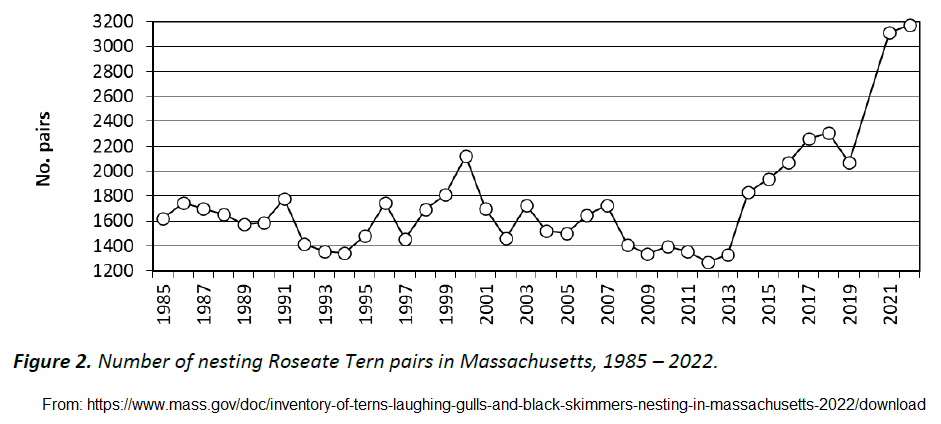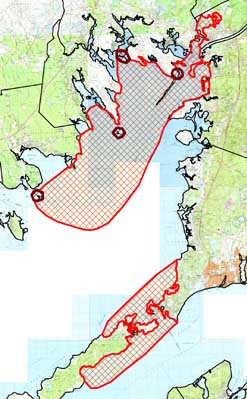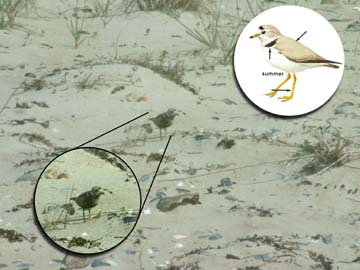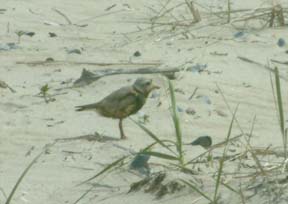Rare and Threatened Bird Species
As noted by the American Bird Conservancy, the United States’ roseate tern population has reached its highest numbers since 1987, when it was listed as a federally Endangered species. The rebound is due to successful habitat restoration and predatory gull management in Buzzards Bay but remains short of the recovery target goal of 5,000 nesting pairs. Below we describe events in Buzzards Bay that contributed to this population rebound.
Roseate Tern Recovery in Buzzards Bay

One half of North America’s breeding pairs of the roseate terns (Sterna dougallii) can be found on two tiny islands in Buzzards Bay. The EPA classifies the species as endangered. Over the past three decades, considerable effort has been put into the study and management of this population to prevent the local extinction of this tern. Most recent efforts include habitat management and gull control on the islands beginning in the early 1990s.
These early protection efforts have paid off, with the return of roseate terns to Ram Island in the mid-1990s for the first time in twenty years. Many of the birds on Ram Island appear to have initially relocated from Bird Island, but with total habitat area increased, the total breeding pair population has been steadily increasing during the past several years, and this trend is expected to continue. Ram Island has now overtaken Bird Island in the number of breeding pairs. Penikese Island, at the southern end of the Elizabeth Island chain is the focus of new efforts to expand roseate tern habitat.
During the 1990s, Bird Island faced severe erosion problems, threatening the tern habitat. To save the island from destruction, and to further manage and protect the tern population, the New Bedford Harbor Trustee Council (managing Natural Resource Damages Assessment funds for that project) awarded more than a million dollars to protect and preserve Bird Island and implement programs to help Roseate terns expand their population in Buzzards Bay. Gull reduction efforts will continue to help protect the existing colonies.
Another problem affecting past tern recovery efforts was the April 2003 Buzzards Bay oil spill, which severely affected Ram Island. To prevent birds from landing on the oiled Island, “hazing” operations using cannons and lights were put into effect to discourage the arrival and nesting of birds on the Island until the oil was cleaned up. Some breeding pairs delayed nesting that year because of the hazing and cleanup activities; more than 250 pairs nested on Penikese Island near the southern tip of the Elizabeth Island chain.
It was hoped that the movement of birds to Penikese Island in 2003 because of the oil spill and hazing operations would help trigger the establishment of a new roseate tern colony in Buzzards Bay on Penikese, but only 9 birds returned to the site in 2004.
Newspaper articles at the time of the oil spill reported that the U.S. Fish and Wildlife Service issued a report estimating that at least 350 roseate tern chicks were lost because of delayed nesting when the parent birds had to be chased away from the island. This represents roughly 10% of annual production. That year, some roseate terns were observed contaminated with oil and three Roseate Terns were found dead, also contaminated with oil. The impacts to Roseate terns and other species and habitat were addressed through the Natural Resource Damage Assessment (NRDA) process. Separate from the NRDA, in November 2004, a $10 million-dollar criminal settlement was finalized relating to the impacts to these and other birds in Buzzards Bay.
Through the early 2000s, the state initiated additional efforts to help roseate tern populations. About 2007, designs for the restoration of Bird Island were funded by the New Bedford Harbor Trustee Council, and the work to restore the island and create more tern nesting habitat was complete. The effort on Bird Island may have paid off, as suggested by the steep rise of nesting pairs in 2021 and 2022 as illustrated in the figure below and as detailed in this 2023 MA Fish and Wildlife report. The state and its partners are still developing a strategy to protect Ram Island. In October 2023, the Bouchard Oil Spill Trustees released a draft plan and environmental assessment to restore natural resources in Buzzards Bay. Elements of the plan include goals to protect and restore Ram Island’s vulnerable roseate and common tern nesting habitat by expanding available tern habitat and minimize shoreline loss. Proposed actions: reduce ongoing shoreline erosion and scour, restore saltmarsh habitat through inland, shoreline, intertidal, and offshore approaches at the island, build higher land elevations on the island and minimize soil loss due to erosion and storm impacts, and reduce wave energies affecting Ram Island, causing shoreline erosion.

In March 2024, Federal and state trustee agencies released the final restoration plan and environmental assessment to restore natural resources in Buzzards Bay impacted by the 2003 Bouchard Barge B-120 oil spill. For more information about the efforts to protect the piping plover and roseate terns in Massachusetts, or the Buzzards Bay Tern Restoration Project, contact state zoologist Carolyn Mostello at
Note: A few pairs sometimes nest on Nashawena Island, but the bars are too small to be seen in the graph.

Did you know the Massachusetts “Right Whale” environmental license plate has the outline of two Roseate Terns?
Buzzards Bay Colonial Bird Nesting and Feeding Areas

Summary map created from a 1991 USF&WS report titled Northeast Coastal Areas Study Significant Coastal Habitats, in the section titled Buzzards Bay Colonial Bird Nesting and Feeding Area. The report notes, “There are two distinct, separate and yet closely related areas comprising this complex: 1) an area on the western and upper portions of Buzzards Bay enclosing two small offshore islands (Ram Island and Bird Island) and a large group feeding area; and 2) a nearshore area of open waters along the lower, eastern shoreline of Buzzards Bay important as a general feeding area for individual birds.”
Massachusetts section of report as a pdf (4.7 MB pdf)
Roseate Tern Links
The Commonwealth of Massachusetts, Natural Heritage & Endangered Species Program (NHESP) Roseate Tern fact sheet has information about the bird in Massachusetts.
The U.S. Fish & Wildlife Service (USFWS) Roseate Tern species profile contains detailed information on the federal status of the bird.
Massachusetts Natural Heritage roseate tern fact sheet
The U.S. Geological Survey (USGS) identification tips for the Roseate Tern and includes other information.
The USGS Roseate Tern fact sheet discusses United States populations.
US Fish and Wildlife Service Coastal Habitats report for Buzzards Bay.
Piping Plover
Piping plover, Charadrius melodus, is a threatened species under both federal and Massachusetts endangered species acts and is also the focus of protection and recovery efforts in Buzzards Bay. The bird is small, sand-colored, and nests on coastal beaches from South Carolina north to Newfoundland. While foraging on beaches, the bird runs, then stops and stands still. This behavior, together with it camouflage coloration, make it very hard to see. Piping Plovers feed on marine worms, crustaceans, and insects in the intertidal.
Piping plover were also affected by the 2003 oil spill, particularly in the Barneys Joy area of Dartmouth. Below are two photographs taken of plover there on May 3, 2003. Some plovers were observed oiled, and these impacts were evaluated.
Massachusetts has developed a MA Piping Plover Habitat Conservation Plan to advance conservation and recovery of piping plover in Massachusetts. Read more about the plan at this Mass Wildlife page.
For more information about the efforts to protect the Piping Plover in Massachusetts, contact state zoologist Carolyn Mostello at 508/792-7270 x312, or by email at Carolyn.mostello@state.ma.us.


Piping Plover Links
Click to read the Massachusetts Fish and Wildlife Massachusetts 2001 Piping Plover status report.
This Massachusetts Natural Heritage Program Piping Plover fact sheet.
USFWS Piping Plover Atlantic Coast Population website has links to recreational management guidelines, information on how to report sightings, and references.
The Commonwealth of Massachusetts NHESP piping plover fact sheet has key information about piping plovers in Massachusetts
The USFWS Piping Plover species profile contains detailed information on its federal status.
For information about habitat in the United States, visit the USFWS Piping Plover species spotlight page.
The USFWS revised plover species recovery plan offers detailed information on the piping plover population on the Atlantic Coast.
National Audubon’s “A Year in the Life of a Piping Plover.“ also contains useful information.
Are you a Piping Plover expert? Test your knowledge by taking this Piping Plover quiz.